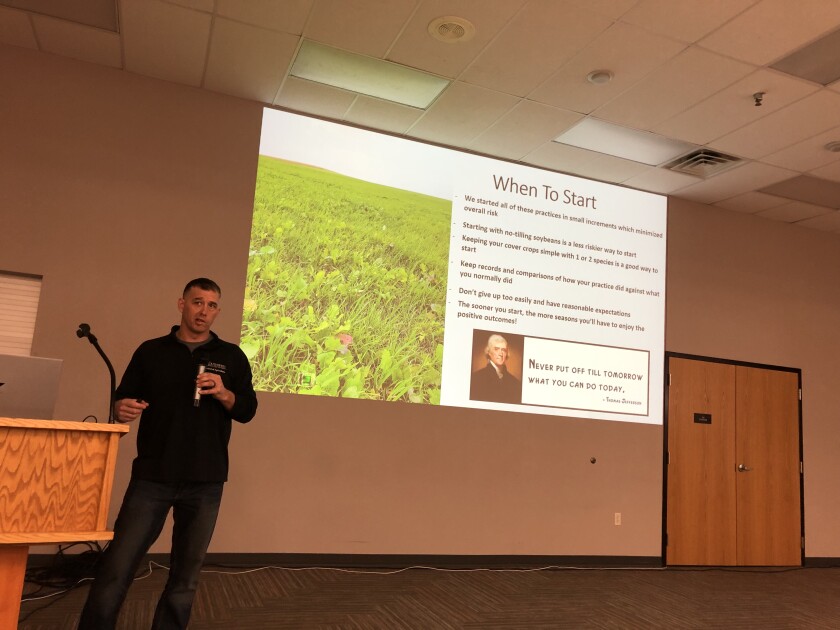Western Minnesota farmers engaged in ‘regenerative agriculture’ say it grows the underside line – West Central Tribune

[ad_1]
— On most any winter’s evening, Phil Smith can glance out over his farmland in western Renville County and see deer browsing in his fields, sometimes as many as 50 to 100 at a time.
“That’s my livestock,” he laughed.
Smith converted his farm to regenerative agriculture, which focuses on building the health of the soil and its microbial populations. He spoke to an audience of farmers at the Business of Soil Health seminar hosted March 1 in Renville by the Hawk Creek Watershed Project and the Renville County Soil and Water Conservation District.
Smith, 62, will be starting his 44th crop year this spring.
“I’m more excited about our farming operation and agriculture than I have been in my lifetime,” he told his audience.
A core principle is to minimize any disturbance of the soil. He plants cover crops, using the seeds of the rye he grows himself as well as a multi-species mix of seeds he purchases.
The practices prevent soil erosion and greatly increase the soil’s ability to hold moisture. Cover crops provide weed control and add nutrients to the soil. He quit applying anhydrous ammonia years ago.
His practices benefit wildlife: The deer scraping through this winter’s snow cover to browse on the cover crops below are evidence of that.

Tom Cherveny / West Central Tribune
Smith and Matt Tiffany, a Redwood County farmer, both shared stories of their conversion to regenerative agriculture. While they both applauded the conservation and wildlife benefits they are witnessing, they emphasized that conservation is not by itself the reason to make the conversion.
It’s economics. They’ve improved their farms’ profitability.
Tiffany made a deliberate, step-by-step process into regenerative agriculture over a number of years. He monitored his costs and yields, acre by acre, each step of the way.
He’s improved profitability on his corn acres in all of the years. The benefits vary by the year, but on his corn acres, the improvement in profit has ranged from $63.11 to as much $130.69 per acre above the profit he recorded using conventional practices.
Smith jumped into regenerative agriculture “headfirst” five years ago. Fellow church members and friends Dawn and Grant Breitkreutz have been proving the benefits of regenerative practices on their Redwood County farm for years, and had urged Smith to try them.

Contributed / Renville County Soil and Water Conservation District
He finally took in a field day at their farm one summer’s day, and within the first hour the light bulb went on, said Smith.
“I only wished I had listened a lot sooner,” Smith told his audience.
Like Tiffany, he put his farm’s economic performance on the screen to show the improved profitability that he has documented.
Last year, Smith hosted his own field day. Along with the economic advantages, he showed the difference in the health and nutritional qualities of plants raised on his soil as compared to plants raised in soil from a neighboring farm using conventional practices.
The nutritional qualities of the plants raised in his soil were as much as 30% and 40% higher. Smith believes the time is coming when consumers will be making their purchasing decisions based on the nutritional value of crops raised in healthy soils.
Smith farms 800 acres of farmland along the bluff of the Minnesota River Valley. The farm has some dark and heavy soil, but is mostly land considered relatively marginal, he said.
“Probably not the most desired ground to farm, but it is what we have to work with and we’re grateful for that,” he said.
He began farming right out of high school in the 1980s.
“It was a real baptism. You looked for any way to survive into the next year,” he said.

Contributed / Scott Tedrick, Renville Register
He experimented through the years, trying rotational grazing and planting soybeans into corn stalks without tillage. He quit deep tillage 15 years ago when he gained access to turkey litter.
He admits there were nervous times for himself and his father as he moved into regenerative practices; perhaps none was so scary as the first year they planted soybeans into standing corn stalks with a live cereal rye cover crop. How would something grow in that, he said his father worried.
He warned his audience: The changes made to regenerative practices will raise some eyebrows and bring some snickers as neighbors see them.
But in just a few years’ time, the changes in the soil structure made evident the benefits. Most surprising for Smith was seeing the improved water infiltration into the soil.
“I can’t describe that to you. You won’t believe it until you see it develop on your own farm,” he said.
His excitement today is in seeing the health of his soil and the crops it produces, as well as the economic benefits.
“Once you see it, you cannot unsee it,” said Smith. “Once you go down the path of regenerative agriculture, you can’t turn back.”
He said it is all about working with instead of against Mother Nature and caring for God’s creation “the way it is supposed to work.”
[ad_2]









